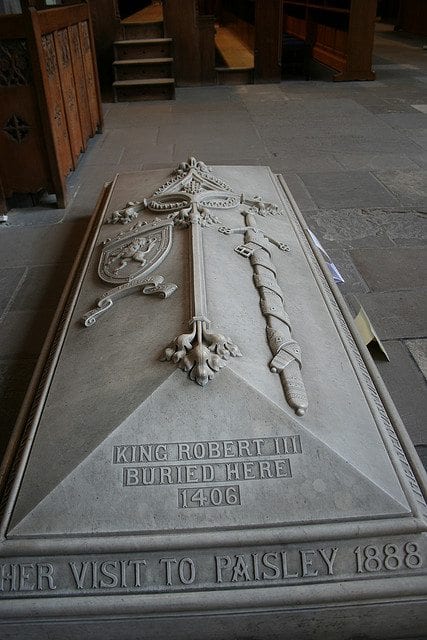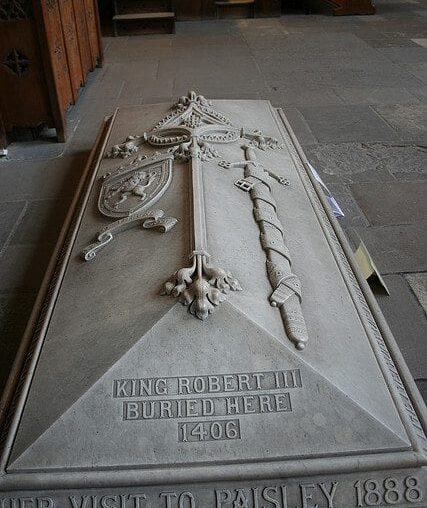The Cradle of the Stewarts
by Claire Casey
As well being known for its mill and weaving history, Paisley also has also been known as a town of churches. Almost anywhere you look in the town, you will see churches, or their spires. This has its roots in the Industrial Revolution, when people from Ireland, the Highlands of Scotland, and elsewhere, all flocked to Paisley for work. This influx of new people and different forms of Christianity meant that new churches had to be built to accommodate all of them. Many of these churches have since found other uses, including an Arts Centre.
Out of all of these different churches, the most famous has to be the town’s Abbey, which can trace its history back to the mid 12th Century. The Abbey is the only building of Paisley’s Clunic monastery that is still standing today. Much of the monastery was destroyed during the Reformation and the subsequent development of Paisley as an industrial centre, which saw much of the monastic stonework being removed for the expansion of Paisley. The peace and quiet that you will find within its walls hides the fact that the monastery and its Abbey church have played an important role in Scotland’s history. This was the case almost right from the day of that this community was founded.
In 1163, a small priory was founded in what is now the town that is now Johnstone. Within 15 years, the entire community was moved to the banks of the White Cart River, where there was once a small church dedicated to St Mirin. This early Christian church has since been lost to history. Within a hundred years of its original founding, the priory finally gained the position of monastery. This reflected the influence and power that this monastic community had gained within that short period of time.
This influence and power can be clearly seen by who the Abbey has been connected to over the centuries. The founder of the original priory was one Walter Fitz Alan, who had come to Scotland with David I. Fitz Alan would go onto become the High Steward of Scotland, a title that Fitz Alan would pass onto his decedents. By the late 13th Century, Fitz Alan’s decedents had taken the name of Stewart, who probably the most famous family to have ever sat on the throne of Scotland. A number of the Stewarts were buried within the monastery’s walls. It is also believed that Robert II, the first Stewart king of Scotland and the grandson of Robert the Bruce, was also born within the walls of Paisley’s monastery.
 The connection between the Paisley Abbey and royalty continues even to this day. There have been a number of occasions when members of the present day royal family have visited the Abbey, all in order to pay their respects to their Stewart forebears. These have included visits from Queen Victoria in 1888, when she dedicated a memorial to Robert II, while the most recent visit was that of Princess Anne in the year 2000.
The connection between the Paisley Abbey and royalty continues even to this day. There have been a number of occasions when members of the present day royal family have visited the Abbey, all in order to pay their respects to their Stewart forebears. These have included visits from Queen Victoria in 1888, when she dedicated a memorial to Robert II, while the most recent visit was that of Princess Anne in the year 2000.
As well as connections to royalty, both past and present, it is also believed that Sir William Wallace was at least partially educated by Paisley’s monks. This was all in the hope that, as the second son of a minor noble, he would go on to become a priest. Obviously, history stepped in and Wallace went on to follow a very different path, which would lead him to the London gallows and immortality. At some point during the Scottish Wars of Independence, the monastery and its Abbey church was attacked by the English army. During this attack, the Abbey was partially destroyed. It has been argued that this attack was carried out either because of the monastery’s connections to Wallace, or because its connections to the Stewarts, who had given their support to the Bruce. Whatever the reasons for the attack, the Abbey was rebuilt.
Unfortunately, the Abbey was again struck by disaster. The Abbey had suffered some fire damage, and during the restoration works, the abbot at the time decided that he wanted the tower of the Abbey to be taller, and for it to have a spire as its crowning glory. This turned out to be a disastrous decision. The stonework of the tower had been weakened by the fire and the strain of the extended tower and spire prove too much, and the tower collapsed, destroying much of the transept and the choir.
The nave of the Abbey was sealed off and used as the parish church of Paisley, while the side chapel, known as the St Mirin’s Chapel, became the private place of worship for the Hamilton family. For about 300 years, the transept and choir were left in ruin, and they were actually used as a graveyard. In the 19th century, the decision was finally made to rebuild what the Abbey had lost. Finally, in 1928, with the rededication of the choir, the Abbey had been returned to its former glory. Therefore, within this one church, you will find building phases from the 13th, 15th, 19th and 20th centuries.
Even though the Abbey church that we see today is not the church that would be remembered by the likes of William Wallace does not take away from the beauty and the grandeur that you will find within its venerable walls. As well as being packed to the rafters with history, the Abbey is also full of little gems. Since the 1930’s, the Abbey has been the home of the Barrochan Cross, a free standing stone cross which once stood on a hillside overlooking the town of Houston. Since it was placed on its Renfrewshire hillside in the 9th Century, it has become the victim of weather erosion.
Sadly, many of the elaborate carvings that once adorned the cross have become so worn that it can be difficult to actually make out many of the designs and motifs. This can all be put down to the passage of time and with the cross having been exposed to the changeable Scottish weather for so long. It was moved to the Abbey in order to try and protect it from any further damage of erosion. Despite the damage that the cross has sustained over the centuries, on certain sections of the cross you can make out some of the designs of motifs that would have covered the entire cross.
Even though the Abbey is still used on a weekly basis for Sunday services, it is open to visitors for the rest of the week. As with so many buildings like this in Scotland, there is no entry fee, even though donations are always welcome. This ease of access will give you the perfect opportunity to explore the history and architectural grandeur of the oldest building in Paisley, where you really can walk in the footsteps of history.
There are plans, at the present, for the west range of the cloisters to be rebuilt. The west range will house a new shop, cafe and exhibition area, as well as opening up the cloister garden to visitors. It is hoped that this project with be completed in the September of 2013, which will be the 850th anniversary of the Abbey’s founding.
All information was supplied to Paisley on the web by Claire Casey.


